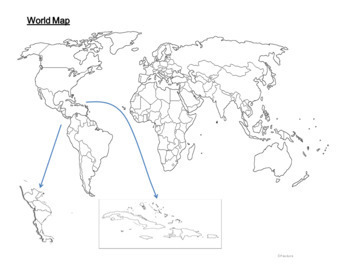United States Imperialism Map

The concept of United States imperialism is a complex and multifaceted topic that has been debated by historians, scholars, and policymakers for decades. At its core, imperialism refers to the extension of a country's power and influence through colonization, military intervention, or economic domination. The United States, as a global superpower, has been accused of engaging in imperialistic practices throughout its history, particularly during the late 19th and early 20th centuries.
Historical Context of United States Imperialism

The United States’ expansionist policies can be traced back to the early 19th century, with the Louisiana Purchase of 1803 and the subsequent westward expansion. However, it wasn’t until the late 19th century that the United States began to assert its influence globally. The Spanish-American War of 1898 marked a significant turning point, as the United States emerged victorious and gained control of several Spanish colonies, including Puerto Rico, Guam, and the Philippines.
Key Events and Policies
The United States’ imperialistic tendencies were further solidified through a series of key events and policies, including the Open Door Policy, the Roosevelt Corollary, and the Taft-Katsura Agreement. The Open Door Policy, introduced by Secretary of State John Hay in 1899, aimed to promote American trade and commerce in China, while the Roosevelt Corollary, introduced by President Theodore Roosevelt in 1904, asserted the United States’ right to intervene in the internal affairs of Latin American countries. The Taft-Katsura Agreement, signed in 1905, recognized Japan’s control over Korea in exchange for Japan’s recognition of the United States’ control over the Philippines.
| Event/Policy | Date | Description |
|---|---|---|
| Louisiana Purchase | 1803 | United States acquires approximately 828,000 square miles of land from France for $15 million |
| Spanish-American War | 1898 | United States defeats Spain, gaining control of several Spanish colonies, including Puerto Rico, Guam, and the Philippines |
| Open Door Policy | 1899 | United States promotes American trade and commerce in China, while also maintaining China's territorial integrity |
| Roosevelt Corollary | 1904 | United States asserts its right to intervene in the internal affairs of Latin American countries to maintain stability and protect American interests |
| Taft-Katsura Agreement | 1905 | United States recognizes Japan's control over Korea in exchange for Japan's recognition of the United States' control over the Philippines |

Maps and Visual Representations

Visual representations, such as maps, can be a powerful tool for understanding the scope and extent of United States imperialism. A map of the United States’ imperial possessions and spheres of influence during the late 19th and early 20th centuries would reveal a vast and complex network of territories, colonies, and dependencies. This map would include the Philippines, Puerto Rico, Guam, Hawaii, and other territories acquired through the Spanish-American War, as well as areas of influence in Central America, the Caribbean, and Asia.
Geographic and Strategic Significance
The geographic and strategic significance of these territories and areas of influence cannot be overstated. The Philippines, for example, provided the United States with a crucial foothold in Southeast Asia, while Puerto Rico and Guam offered strategic military bases and coaling stations. Hawaii, annexed by the United States in 1898, became a vital hub for American trade and commerce in the Pacific.
Key Points
- The United States' imperialistic policies and practices have been shaped by a complex array of historical, economic, and strategic factors.
- Key events, such as the Spanish-American War and the introduction of the Open Door Policy, have played a significant role in shaping American imperialism.
- Visual representations, such as maps, can provide valuable insights into the scope and extent of United States imperialism.
- The geographic and strategic significance of the United States' imperial possessions and spheres of influence has had a profound impact on global politics, economies, and societies.
- Understanding the ongoing influence and implications of American imperialism is essential for analyzing its role in shaping contemporary global affairs.
Critiques and Controversies
The United States’ imperialistic policies and practices have been subject to intense critique and controversy. Many argue that American imperialism has been driven by a desire to expand its economic and military power, often at the expense of other nations and peoples. Others contend that the United States’ imperialistic tendencies have been justified by a sense of exceptionalism and a belief in the country’s mission to spread democracy and freedom.
Debates and Discussions
These debates and discussions highlight the complex and multifaceted nature of United States imperialism. While some argue that American imperialism has brought stability and prosperity to certain regions, others contend that it has led to exploitation, oppression, and violence. As the United States continues to play a dominant role in global affairs, understanding the critiques and controversies surrounding its imperialistic policies and practices is essential for navigating the complexities of contemporary international relations.
What is the definition of imperialism, and how has it been applied to the United States?
+Imperialism refers to the extension of a country's power and influence through colonization, military intervention, or economic domination. The United States has been accused of engaging in imperialistic practices throughout its history, particularly during the late 19th and early 20th centuries.
What were the key events and policies that shaped American imperialism?
+The key events and policies that shaped American imperialism include the Spanish-American War, the Open Door Policy, the Roosevelt Corollary, and the Taft-Katsura Agreement. These events and policies marked significant turning points in the United States' expansionist policies and its assertion of influence globally.
How have visual representations, such as maps, been used to understand the scope and extent of United States imperialism?
+Visual representations, such as maps, have been used to illustrate the geographic and strategic significance of the United States' imperial possessions and spheres of influence. These maps provide valuable insights into the scope and extent of American imperialism, highlighting the complex network of territories, colonies, and dependencies that have been acquired through military intervention, economic domination, or colonization.
In conclusion, the United States’ imperialistic policies and practices have had a profound impact on global politics, economies, and societies. Understanding the historical context, key events, and critiques surrounding American imperialism is essential for analyzing its ongoing influence and implications. As the United States continues to play a dominant role in global affairs, it is crucial to recognize the complexities and controversies surrounding its imperialistic tendencies and to engage in nuanced and informed discussions about its role in shaping contemporary international relations.



